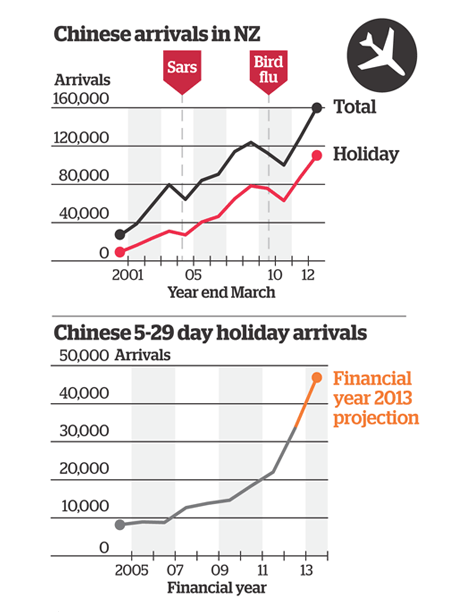Chinese visitor numbers are booming, and importantly for New Zealand tourism their stay here is increasing.
Latest figures show Chinese visitor numbers have rocketed from around 30,000 in 2000 to around 180,000 in the current year.
For the year to August they spent $522 million here.
Tourism New Zealand regards China as a top tier market to target and is with airlines and airports spending tens of millions of dollars on boosting these numbers.
The total market is enormous. Last year about 70 million Chinese took overseas trips spending more than $90 billion and New Zealand is in a battle to attract more visits against 140 other countries, for which China’s government grants passports, to attract more visits.
One inbound tourist operator said China was seen as “a pot of gold” but if not done right New Zealand companies risked missing out while industry leaders stress the Chinese market can’t be seen as “an economic transaction”.
Tourism NZ’s general manager of Asian markets Tony Everitt said the spectacular growth of the past decade was expected to continue and the growth in the length of stay – a measure of the spending power of a market – was also exciting. Most visitors are here on holiday and stay an average of 6.1 days – 10 days less than the international average – but numbers spending five to 29 days here are forecast to grow by a third over the next year.
Everitt said during the next three years it was hoped up to 50,000 Chinese visitors could be in the long- stay category, more than the total Japanese and German leisure market.
Everitt is based in Shanghai and said he sees no evidence of the “so called” economic slowdown in China.
“To be quite honest we don’t see any evidence of that on the streets and we don’t see any evidence of that impacting Chinese visitors in the near-term.”

Tourism NZ uses its 100 per cent Pure New Zealand campaign in China as in other markets.
“The promise of having fun in a stunning natural setting is a key drawcard.”
The organisation uses Chinese “opinion leaders”, particularly actress Yao Chen who is its brand ambassador and who has been shown enjoying New Zealand.
Guangzhou-based China Southern Airlines has been flying direct to Auckland for the past 18 months – for most of that time daily – and has been a factor in the big increase in the number of Chinese tourists.
Its sales manager in New Zealand, Valerie Wang, said demand had increased steadily made up of those visiting friends and relatives, students, the meetings, incentives, conventions and exhibitions (Mice) market and general business.
“New Zealand is still a fresh destination to most of the Chinese travellers.”
This county could do more, she said.
Consulates, such as that in Guangzhou, could process visas more efficiently, increase the capacity within the industry especially for the bigger spending visitors and Mice groups and it could learn from what other countries such as Singapore, the Netherlands and Australia had done to market themselves in China.
Southern China Airlines spent about $10 million promoting New Zealand in China last year. A new air services agreement allows a trebling in the number of daily flights between New Zealand and China although Southern China says it has no plans to increase services.
Air New Zealand has this year changed its strategy in China, avoiding the often clogged airspace around Beijing and concentrating on Shanghai. It has flown five times a week to Shanghai since July and will boost this to daily from January. Its deputy chief executive Norm Thompson, a tourist industry veteran, this year told the Trenz conference the airline was working on a number of initiatives in the local market to increase the number of Chinese visitors choosing to travel directly and exclusively to New Zealand. This included only featuring New Zealand tour itineraries in campaigns with key local partners.
Hong Kong-based Cathay Pacific said there was growing interest from the mainland for its New Zealand services and it would again increase the number of flights to twice a day over summer.
Country manager for New Zealand and the Pacific Islands Ken Chiu said demand was “reasonably good” on the Hong Kong-Auckland route.
The clean natural environment was a drawcard but so too was shopping and one-way retailers could do better by staying open longer.
Advice for success
Do
*Make friends first, business will follow. Wine and dine them, take an interest in them as individuals.
*Respect hierarchy.
*Use diplomatic communication.
*Use properly translated Chinese materials.
*Give well packaged and thoughtful gifts. They are another chance to build on your GuanXi (relationships).
Don’t
*Launch straight into business. Don’t jump straight into the deal, you’ll need to earn their trust and respect first.
*Overlook the power of GuanXi. Relationships with the right people in the hierarchy can get you places.
*Be afraid to use compliments. Don’t be afraid to use flattery, they will help massage your GuanXi.
*Use Google translate. Chinese is a contextual language. Don’t risk your messages being lost in translation.
*Give clocks. It implies ‘your time is up’.
Stick to the plan
An inbound tourism firm targeting more affluent visitors from China says operators here should be wary of trying too hard to tailor their businesses to what they think Chinese people want.
“Stick to what you’ve been offering, don’t change the tour to tailor it to them,” said Kenneth Wong, Asia market manager of Magnetic South, a part of the House of Travel group.
“You are what you are and I don’t believe changing the product will help.”
Wong’s company has for the last year targeted free independent travellers (Fit) and small groups, often families visiting relatives or the incentive market.
This is about 10 per cent of the market.
